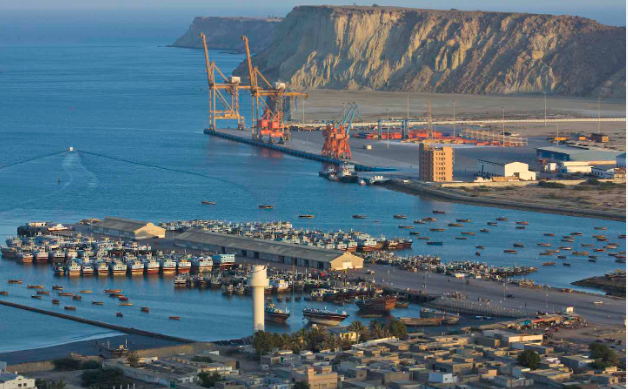
On Monday, India signed a 10-year contract to extend the development and operation of the Chabahar port on the Gulf of Oman.
The agreement between Indian and Iranian port authorities is a major step in India’s long-running ambition to secure a transit route for Indian goods to markets in Iran, Afghanistan, Central Asia and beyond.
Under the agreement, signed between Indian Ports Global Limited (IPGL) and the Ports and Maritime Organization of Iran (PNO), India will invest a total of $370 million (€341.7 million) in development and financing of the port.
US warns against doing business with Iran
After the deal was inked in Tehran, US State Department deputy spokesperson Vedant Patel told reporters that “anyone considering business deals with Iran” needs to “be aware of the potential risk” of sanctions they are “opening themselves up to.”
“US sanctions on Iran remain in place and we will continue to enforce them,” Patel said.
In turn, India’s Foreign Minister S Jaishankar commented that the United States had been “appreciative” of the port’s “larger relevance” in the past.
In 2018, the United States exempted the port’s operations from sanctions to allow the flow of goods and fuel to war-torn Afghanistan. The terminal has handled more than 90,000 units of container traffic and 2.5 million tons of wheat and other aid for Afghanistan.
“I think it’s a question of communicating, convincing, and getting people to understand that this is actually for everyone’s benefit. I do not think people should take a narrow view of it,” Jaishankar said.
Growing gap between India and US
Indian public policy expert Shanthie Mariet D’Souza, currently a Fulbright-Nehru Visiting Chair in public policy at the University of Massachusetts-Amherst, told DW that the specificity of how sanctions could impact Chabahar’s operations remains unclear.
“US sanctions can minimize the full potential of Chabahar as a trade hub,” she said.
“However, India’s assertive foreign policy choices on the Ukraine war, oil and arms imports from Russia, supporting the Myanmar military, and doing business with Iran, which are at variance with policies pursued by Washington, could compel the Biden administration to opt for a different policy towards New Delhi,” she added.
Expanding Chabahar port a decadeslong goal
India’s interest in developing the Chabahar port goes all the way back to 2003, when a “strategic road map” was signed with Iran. The port itself was first opened during the Iran-Iraq war in 1983.
It wasn’t until 2016 that India began refurbishment of a cargo berth and a shipping container terminal. In 2018, India took over operations at Chabahar.
“The project has been moving in fits and starts for over two decades. There was pressure also from the US when sanctions were imposed by the Donald Trump administration in 2018. But India managed to get a waiver, citing Afghanistan as a reason,” Aftab Kamal Pasha, a former director of Gulf studies at India’s Jawaharlal Nehru University, told DW.
“We will need to underline our strategic autonomy and the belief that the country remains vital to US interests in the region particularly as a counter to China,” Pasha said.
India aims to curb ties between China and Pakistan
The geopolitical implications of Chabahar’s expansion become clearer when looking 100 kilometers down the coastline and across the border to the Pakistani port of Gwadar.
India wants to counter China’s partnership with Pakistan and Beijing’s growing influence in the Gulf of Oman region. India sees its position as a regional power challenged by the port at Gwadar, along with the close cooperation between China and Pakistan.
China has invested billions in trade route infrastructure projects known as the “China-Pakistan Economic Corridor” under the Belt and Road Initiative. China is investing in the Gwadar port to serve as Beijing’s gateway to global markets via the Indian Ocean.
The long-standing conflict between India and Pakistan has made it difficult for India to establish a secure transit route to markets in Iran, Afghanistan, Central Asia and the Gulf region.
Pakistan forbids land transit of Indian goods across its territory. By funding the expansion of Chabahar Port, India solves this access problem with a secure transit route.
Foad Izadi, senior faculty member in the Department of International Relations at Tehran University, told DW that India’s “proactive approach towards Chabahar” reflects a calculated move to assert its regional presence and “strategically counterbalance China’s influence.”
Izadi said India’s expanding economy presented a wealth of opportunities for countries in the region, with Iran poised to capitalize as a pivotal transit point towards central Asia and Russia.
A new trade route to Russia via Iran?
When expanded, the port could also be included in plans for the North-South Transport Corridor (INSTC) project, a multinode road, rail and sea route that was agreed upon by India, Iran and Russia in 2022.
It is envisioned to link the Indian Ocean and Persian Gulf to the Caspian Sea via Iran and onward to Russia.
“Chabahar and its future integration with INSTC is important for India, especially when the prospect for the India-Middle East-Europe Economic Corridor (IMEC) project is bleak,” D’Souza said.
Gulshan Sachdeva, professor at Jawaharlal Nehru University’s school of international affairs, told DW that “the inclusion of the INSTC linked with the Chabahar port would be a crucial component” of a long-term Indian strategy to connect with more global markets.
“With huge India-Russia energy trade, and India’s growing engagement in the south Caucasus, particularly defense exports to Armenia, INSTC may become more viable,” he said.
Sachdeva pointed out that because of the Ukraine war, linking European countries though Russia via INSTC may not be possible now but there are options of linking them though Iran-Armenia-Georgia and Black Sea route.
“Sanctions imposed by the US on Russia and Iran have created complexities, especially for private companies with Western exposure. However, Indian policymakers are determined to find ways to deal with US designs,” added Sachdeva.
source : dw.com
